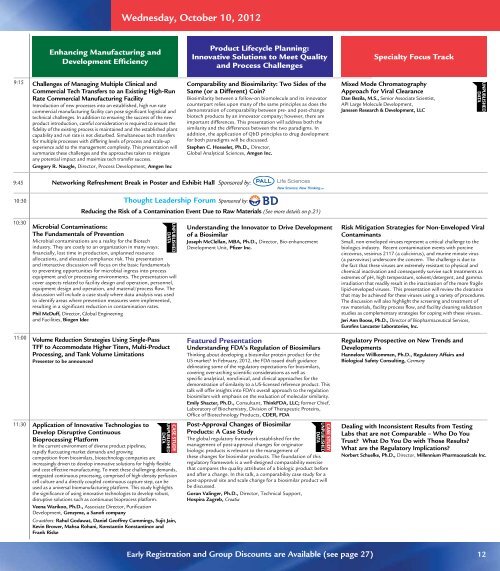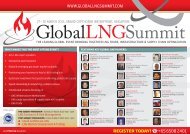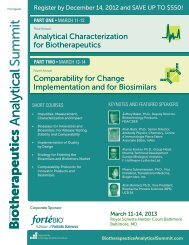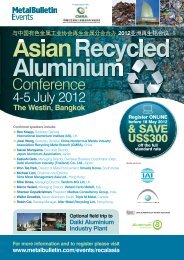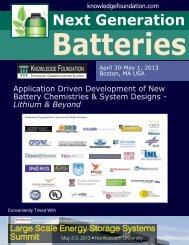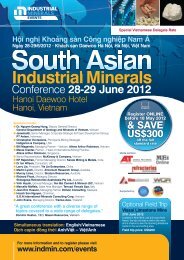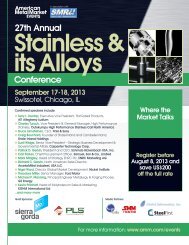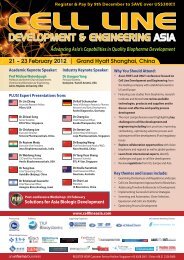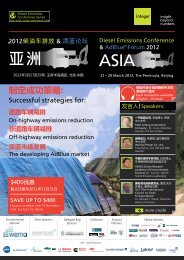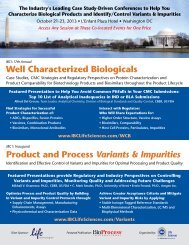Full Conference Details Inside
Full Conference Details Inside
Full Conference Details Inside
Create successful ePaper yourself
Turn your PDF publications into a flip-book with our unique Google optimized e-Paper software.
9:15<br />
10:30<br />
11:00<br />
11:30<br />
Enhancing Manufacturing and<br />
Development Efficiency<br />
Challenges of Managing Multiple Clinical and<br />
Commercial Tech Transfers to an Existing High-Run<br />
Rate Commercial Manufacturing Facility<br />
Introduction of new processes into an established, high run rate<br />
commercial manufacturing facility can pose significant logistical and<br />
technical challenges. In addition to ensuring the success of the new<br />
product introduction, careful consideration is required to ensure the<br />
fidelity of the existing process is maintained and the established plant<br />
capability and run rate is not disturbed. Simultaneous tech transfers<br />
for multiple processes with differing levels of process and scale-up<br />
experience add to the management complexity. This presentation will<br />
summarize these challenges and the approaches taken to mitigate<br />
any potential impact and maximize tech transfer success.<br />
Gregory R. Naugle, Director, Process Development, Amgen Inc<br />
Wednesday, October 10, 2012<br />
9:45 Networking Refreshment Break in Poster and Exhibit Hall Sponsored by:<br />
Product Lifecycle Planning:<br />
Innovative Solutions to Meet Quality<br />
and Process Challenges<br />
10:30 Thought Leadership Forum Sponsored by:<br />
Reducing the Risk of a Contamination Event Due to Raw Materials (See more details on p.21)<br />
Microbial Contaminations:<br />
The Fundamentals of Prevention<br />
Microbial contaminations are a reality for the Biotech<br />
industry. They are costly to an organization in many ways:<br />
financially, lost time in production, unplanned resource<br />
allocations, and elevated compliance risk. This presentation<br />
and interactive discussion will focus on the basic fundamentals<br />
to preventing opportunities for microbial ingress into process<br />
equipment and/or processing environments. The presentation will<br />
cover aspects related to facility design and operation, personnel,<br />
equipment design and operation, and material/process flow. The<br />
discussion will include a case study where data analysis was used<br />
to identify areas where prevention measures were implemented,<br />
resulting in a significant reduction in contamination rates.<br />
Phil McDuff, Director, Global Engineering<br />
and Facilities, Biogen Idec<br />
Volume Reduction Strategies Using Single-Pass<br />
TFF to Accommodate Higher Titers, Multi-Product<br />
Processing, and Tank Volume Limitations<br />
Presenter to be announced<br />
Application of Innovative Technologies to<br />
Develop Disruptive Continuous<br />
Bioprocessing Platform<br />
UNPUBLISHED<br />
DATA<br />
CASE STUDY<br />
UNPUBLISHED<br />
DATA<br />
In the current environment of diverse product pipelines,<br />
rapidly fluctuating market demands and growing<br />
competition from biosimilars, biotechnology companies are<br />
increasingly driven to develop innovative solutions for highly flexible<br />
and cost effective manufacturing. To meet these challenging demands,<br />
integrated continuous processing, comprised of high-density perfusion<br />
cell culture and a directly coupled continuous capture step, can be<br />
used as a universal biomanufacturing platform. This study highlights<br />
the significance of using innovative technologies to develop robust,<br />
disruptive solutions such as continuous bioprocess platform.<br />
Veena Warikoo, Ph.D., Associate Director, Purification<br />
Development, Genzyme, a Sanofi company<br />
Co-authors: Rahul Godawat, Daniel Geoffrey Cummings, Sujit Jain,<br />
Kevin Brower, Mahsa Rohani, Konstantin Konstantinov and<br />
Frank Riske<br />
Comparability and Biosimilarity: Two Sides of the<br />
Same (or a Different) Coin?<br />
Biosimilarity between a follow-on biomolecule and its innovator<br />
counterpart relies upon many of the same principles as does the<br />
demonstration of comparability between pre- and post-change<br />
biotech products by an innovator company; however, there are<br />
important differences. This presentation will address both the<br />
similarity and the differences between the two paradigms. In<br />
addition, the application of QbD principles to drug development<br />
for both paradigms will be discussed.<br />
Stephen C. Hosselet, Ph.D., Director,<br />
Global Analytical Sciences, Amgen Inc.<br />
Understanding the Innovator to Drive Development<br />
of a Biosimilar<br />
Joseph McClellan, MBA, Ph.D., Director, Bio-enhancement<br />
Development Unit, Pfizer Inc.<br />
Featured Presentation<br />
Understanding FDA’s Regulation of Biosimilars<br />
Thinking about developing a biosimilar protein product for the<br />
US market? In February, 2012, the FDA issued draft guidance<br />
delineating some of the regulatory expectations for biosimilars,<br />
covering over-arching scientific considerations as well as<br />
specific analytical, nonclinical, and clinical approaches for the<br />
demonstration of similarity to a US-licensed reference product. This<br />
talk will offer insights into FDA’s overall approach to the regulation<br />
biosimilars with emphasis on the evaluation of molecular similarity.<br />
Emily Shacter, Ph.D., Consultant, ThinkFDA, LLC; former Chief,<br />
Laboratory of Biochemistry, Division of Therapeutic Proteins,<br />
Office of Biotechnology Products, CDER, FDA<br />
Post-Approval Changes of Biosimilar<br />
Products: A Case Study<br />
The global regulatory framework established for the<br />
management of post-approval changes for originator<br />
biologic products is relevant to the management of<br />
these changes for biosimilar products. The foundation of this<br />
regulatory framework is a well-designed comparability exercise<br />
that compares the quality attributes of a biologic product before<br />
and after a change. In this talk, a comparability case study for a<br />
post-approval site and scale change for a biosimilar product will<br />
be discussed.<br />
Goran Valinger, Ph.D., Director, Technical Support,<br />
Hospira Zagreb, Croatia<br />
CASE STUDY<br />
UNPUBLISHED<br />
DATA<br />
Specialty Focus Track<br />
Mixed Mode Chromatography<br />
Approach for Viral Clearance<br />
Dan Bezila, M.S., Senior Associate Scientist,<br />
API Large Molecule Development,<br />
Janssen Research & Development, LLC<br />
UNPUBLISHED<br />
DATA<br />
Risk Mitigation Strategies for Non-Enveloped Viral<br />
Contaminants<br />
Small, non-enveloped viruses represent a critical challenge to the<br />
biologics industry. Recent contamination events with porcine<br />
circovirus, vesivirus 2117 (a calicivirus), and murine minute virus<br />
(a parvovirus) underscore the concern. The challenge is due to<br />
the fact that these viruses are extremely resistant to physical and<br />
chemical inactivation and consequently survive such treatments as<br />
extremes of pH, high temperature, solvent/detergent, and gamma<br />
irradiation that readily result in the inactivation of the more fragile<br />
lipid-enveloped viruses. This presentation will review the clearance<br />
that may be achieved for these viruses using a variety of procedures.<br />
The discussion will also highlight the screening and treatment of<br />
raw materials, facility process flow, and facility cleaning validation<br />
studies as complementary strategies for coping with these viruses..<br />
Jeri Ann Boose, Ph.D., Director of Biopharmaceutical Services,<br />
Eurofins Lancaster Laboratories, Inc.<br />
Regulatory Prospective on New Trends and<br />
Developments<br />
Hannelore Willkommen, Ph.D., Regulatory Affairs and<br />
Biological Safety Consulting, Germany<br />
Dealing with Inconsistent Results from Testing<br />
Labs that are not Comparable – Who Do You<br />
Trust? What Do You Do with Those Results?<br />
What are the Regulatory Implications?<br />
Norbert Schuelke, Ph.D., Director, Millennium Pharmaceuticals Inc.<br />
Early Registration and Group Discounts are Available (see page 27) 12


